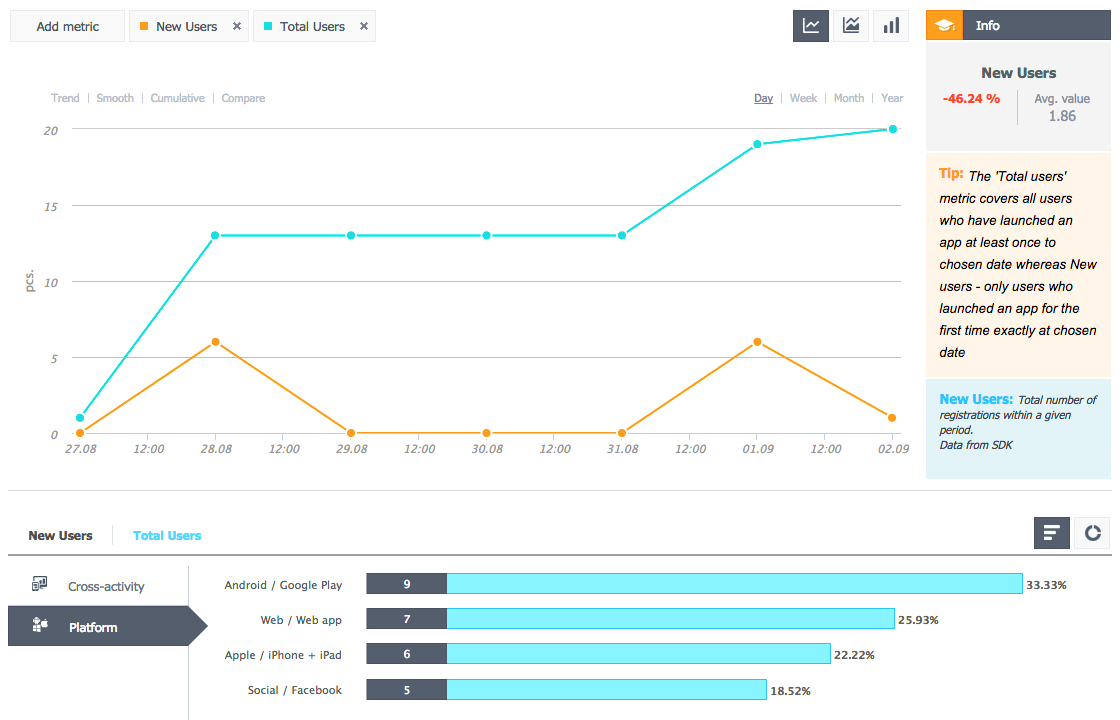About cross-platform analytics and why we launched it
The modern world is on the path to universal integration. The current generation is called screenagers (from the English screen - screen, age - age, by analogy with teenager - teenager). The attention of the current audience is constantly switching between five screens: TV, cinema screen, computer, tablet and smartphone.

Applications are increasingly being released on several platforms at once, to be closer to users, and become cross-platform. And, of course, such applications need appropriate analytics.
Analytical service devtodev.com is pleased to introduce you to cross-platform analytics. Let's get together what it is and why it is so cool.
What are the benefits of cross-platform?
More users
The more platforms an application chooses, the more users will be able to install it on their devices. The iOS and Android markets compete with each other for users, and the cross-platform application allows users from both markets to be instantly available.
Marketing becomes easier
With such a large audience, there is no need to target marketing to narrow segments of users - you can contact everyone at once. The problem of choosing means of communication with the user is becoming less urgent - you can choose any means of disseminating information to your audience.
Improving Resource Efficiency
Modern tools allow you to develop one application that will be available for several platforms at once. Total, with the same labor costs, you increase your audience and, accordingly, cash flows.
The disadvantages of cross-platform used to be called the difficulty in analyzing applications on different platforms. However, now this is not the case, and devtodev removes these problems from developers of cross-platform applications.
How does cross-platform analytics work?
Cross-platform in devtodev works for the following platforms:
If your application runs on several platforms from the list, then you can experience all the advantages of cross-platform analytics.
Each platform has its own characteristics. It has long been known that Google Play is significantly ahead of the iOS App Store in the number of installed applications. But at the same time, the iOS App Store is ahead of Google Play in revenue. Users of iOS devices, although in the minority, are more likely to purchase paid content.

Image source
If we talk about other metrics, then, for example, user retention, according to our data , is highest on Windows Phone. This is understandable because there are simply fewer applications on Windows Phone, and the competition between applications for the minute of user leisure is lower.
It turns out that the behavior of users in the application differs on different platforms: this may be due to the conditions of the market, the tendency of people to monetize, and simply the interface features of the devices themselves.

Cross-platform analytics allows you to see these differences between users by platform. You can calculate the indicators you are interested in for each platform, compare them with each other, identify problems, outline development paths for different platforms. Cross-platform will help you make strategic decisions on the development of platforms and, ultimately, make more money.
On the other hand, cross-platform analytics can abstract from the concept of a platform. If the same user prefers to open the application on several devices within the same period, then it is important for you to analyze its behavior regardless of the device and platform. After all, all this time he remains the same your user, and the platform here is only a means of communication between him and you. Therefore, all analytics in devtodev can be calculated both depending on the platforms, and regardless of them.
We are talking about such metric groups as:
We give an example.
Let's say your application is accessible via the web, as well as on smartphones and tablets running iOS and Android, and you want to compare the performance of platforms.
The following values are available:

Knowing these values, you can evaluate their relationship to each other. However, does this mean that the total project MAU is 30,000 + 40,000 + 50,000 = 120,000? No, because the same user can log into the application from different platforms. And it is important to track the audience of each individual platform, and the project as a whole.
The total MAU is actually 100,000 users. It turns out, if it were not possible to track the overall MAU, we would be 20% mistaken, and such an error is unacceptable to track the dynamics of the indicator.
Also, the cut across platforms allows you to compare the effectiveness of user retention on different platforms with each other. In our example for iOS and Android, new users account for 20% of the total monthly audience. But in the web version - all 50%. The hypothesis may be several:
Be that as it may, this is another question that the developer must answer. It is possible that by correcting the error that affects the retention of users of the web version, we can increase its LTV, and therefore increase the overall LTV and earn more.
Cross-platform analytics devtodev also allows you to compare users who have selected one platform and several platforms at once.
How many users put an application on multiple platforms? Can such users be called more loyal? How much better are these users monetized? Does it make sense to encourage users to use multiple platforms at the same time? Devtodev analytics will answer these questions.
Let's go back to the example.
It is likely that users of our application, simultaneously playing on Android and iOS, are more loyal to us (otherwise why would they put our application on both platforms?). We can calculate the monetization metrics (LTV, ARPU, ARPPU, the share of paying) for such users, and if the hypothesis that they are monetized better works, then it makes sense to drag other users to use several platforms at the same time. By launching the “Log in with Android and get a gift” promotion, we will increase the percentage of loyal users in our audience, which will not slow us down on our money.

For what cases do you need cross-platform analytics?
A great example of a cross-platform game is Hearthstone: Heroes of Warcraft from Blizzard. According to Superdata research , this game makes $ 20 million per month. And the total number of players exceeded 30 million users.

This game is available for computers, and for smartphones, and for tablets, both for iOS and Android. At the same time, the card mechanics of the game allows users to compete with each other, no matter what platform they play on. Cross-platform in action! All Hearthstone players are united in one large ecosystem, and it does not matter for the player which platform he plays with and which one his opponent plays with.

Moreover, one and the same user can play Hearthstone from different platforms during the day: in the morning play a game or two from a tablet, in the subway from a telephone, and at work, secretly from the boss, play from a computer. Of course, there is no question that the user had a separate account on each platform, with a separate deck and the balance of the game currency.
There is no doubt that the Blizzard guys are asking the following questions:
Correctly posed questions and reliable answers to them allow Bizzard to optimize his game for each platform, make strategic decisions on the development of new platforms (for example, recently the owners of the Samsung Galaxy S6 could receive three classic decks plus an exclusive cover for cards for free). As a result, Hearthstone is gaining more and more users who stay in the game for a long time, and bring Blizzard even more money.
What will happen to cross-platform in the future?
The trend towards an increase in the number of cross-platform applications on the market allows us to believe that cross-platform for a long time, if not forever, will become a key trend in application development. Therefore, manage to make your application cross-platform right now, and choose devtodev for analytics.

Applications are increasingly being released on several platforms at once, to be closer to users, and become cross-platform. And, of course, such applications need appropriate analytics.
Analytical service devtodev.com is pleased to introduce you to cross-platform analytics. Let's get together what it is and why it is so cool.
What are the benefits of cross-platform?
More users
The more platforms an application chooses, the more users will be able to install it on their devices. The iOS and Android markets compete with each other for users, and the cross-platform application allows users from both markets to be instantly available.
Marketing becomes easier
With such a large audience, there is no need to target marketing to narrow segments of users - you can contact everyone at once. The problem of choosing means of communication with the user is becoming less urgent - you can choose any means of disseminating information to your audience.
Improving Resource Efficiency
Modern tools allow you to develop one application that will be available for several platforms at once. Total, with the same labor costs, you increase your audience and, accordingly, cash flows.
The disadvantages of cross-platform used to be called the difficulty in analyzing applications on different platforms. However, now this is not the case, and devtodev removes these problems from developers of cross-platform applications.
How does cross-platform analytics work?
Cross-platform in devtodev works for the following platforms:
- iOS
- Android
- Windows (starting from 8.1);
- web.
If your application runs on several platforms from the list, then you can experience all the advantages of cross-platform analytics.
Each platform has its own characteristics. It has long been known that Google Play is significantly ahead of the iOS App Store in the number of installed applications. But at the same time, the iOS App Store is ahead of Google Play in revenue. Users of iOS devices, although in the minority, are more likely to purchase paid content.

Image source
If we talk about other metrics, then, for example, user retention, according to our data , is highest on Windows Phone. This is understandable because there are simply fewer applications on Windows Phone, and the competition between applications for the minute of user leisure is lower.
It turns out that the behavior of users in the application differs on different platforms: this may be due to the conditions of the market, the tendency of people to monetize, and simply the interface features of the devices themselves.

Cross-platform analytics allows you to see these differences between users by platform. You can calculate the indicators you are interested in for each platform, compare them with each other, identify problems, outline development paths for different platforms. Cross-platform will help you make strategic decisions on the development of platforms and, ultimately, make more money.
On the other hand, cross-platform analytics can abstract from the concept of a platform. If the same user prefers to open the application on several devices within the same period, then it is important for you to analyze its behavior regardless of the device and platform. After all, all this time he remains the same your user, and the platform here is only a means of communication between him and you. Therefore, all analytics in devtodev can be calculated both depending on the platforms, and regardless of them.
We are talking about such metric groups as:
- new users;
- user activity (DAU, MAU, sticky factor, lifetime, and so on);
- absolute monetization metrics (income before and after deducting the commission of the market, the number of transactions, the number of paying users);
- relative monetization metrics (percentage of payers, ARPU, ARPPU, average check, LTV and so on).
We give an example.
Let's say your application is accessible via the web, as well as on smartphones and tablets running iOS and Android, and you want to compare the performance of platforms.
The following values are available:

Knowing these values, you can evaluate their relationship to each other. However, does this mean that the total project MAU is 30,000 + 40,000 + 50,000 = 120,000? No, because the same user can log into the application from different platforms. And it is important to track the audience of each individual platform, and the project as a whole.
The total MAU is actually 100,000 users. It turns out, if it were not possible to track the overall MAU, we would be 20% mistaken, and such an error is unacceptable to track the dynamics of the indicator.
Also, the cut across platforms allows you to compare the effectiveness of user retention on different platforms with each other. In our example for iOS and Android, new users account for 20% of the total monthly audience. But in the web version - all 50%. The hypothesis may be several:
- either the web version was recently released and is only gaining users,
- either there is an active purchase of traffic in the web version,
- or there is a problem in retaining users in the web version.
Be that as it may, this is another question that the developer must answer. It is possible that by correcting the error that affects the retention of users of the web version, we can increase its LTV, and therefore increase the overall LTV and earn more.
Cross-platform analytics devtodev also allows you to compare users who have selected one platform and several platforms at once.
How many users put an application on multiple platforms? Can such users be called more loyal? How much better are these users monetized? Does it make sense to encourage users to use multiple platforms at the same time? Devtodev analytics will answer these questions.
Let's go back to the example.
It is likely that users of our application, simultaneously playing on Android and iOS, are more loyal to us (otherwise why would they put our application on both platforms?). We can calculate the monetization metrics (LTV, ARPU, ARPPU, the share of paying) for such users, and if the hypothesis that they are monetized better works, then it makes sense to drag other users to use several platforms at the same time. By launching the “Log in with Android and get a gift” promotion, we will increase the percentage of loyal users in our audience, which will not slow us down on our money.

Dmitry Kravtsov, CEO of devtodev: The
trend towards the development of cross-platform applications is evident. However, you need to be able to analyze them, and the market did not have any in-depth analytics that would suit the developers of such applications. We decided to remove these problems from the developers and offer our cross-platform analytics functionality. I’m sure developers will see the benefits of our analytics, they will be able to develop their applications in the right direction and earn more.
For what cases do you need cross-platform analytics?
A great example of a cross-platform game is Hearthstone: Heroes of Warcraft from Blizzard. According to Superdata research , this game makes $ 20 million per month. And the total number of players exceeded 30 million users.

This game is available for computers, and for smartphones, and for tablets, both for iOS and Android. At the same time, the card mechanics of the game allows users to compete with each other, no matter what platform they play on. Cross-platform in action! All Hearthstone players are united in one large ecosystem, and it does not matter for the player which platform he plays with and which one his opponent plays with.

Moreover, one and the same user can play Hearthstone from different platforms during the day: in the morning play a game or two from a tablet, in the subway from a telephone, and at work, secretly from the boss, play from a computer. Of course, there is no question that the user had a separate account on each platform, with a separate deck and the balance of the game currency.
There is no doubt that the Blizzard guys are asking the following questions:
- how many users play on each platform;
- how much money each platform brings;
- what is the effectiveness of the platform;
- is there any difference on which platform the player first played;
- Are there distortions when players on one platform have a higher percentage of victories than on another?
- how many users play on multiple platforms;
- How users using multiple platforms are monetized
- how many users live in the game on each platform;
- etc.
Correctly posed questions and reliable answers to them allow Bizzard to optimize his game for each platform, make strategic decisions on the development of new platforms (for example, recently the owners of the Samsung Galaxy S6 could receive three classic decks plus an exclusive cover for cards for free). As a result, Hearthstone is gaining more and more users who stay in the game for a long time, and bring Blizzard even more money.
What will happen to cross-platform in the future?
The trend towards an increase in the number of cross-platform applications on the market allows us to believe that cross-platform for a long time, if not forever, will become a key trend in application development. Therefore, manage to make your application cross-platform right now, and choose devtodev for analytics.
